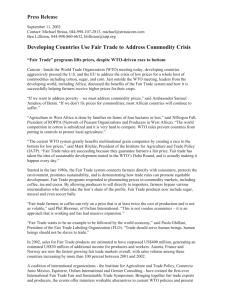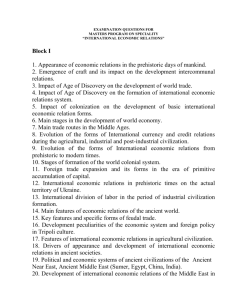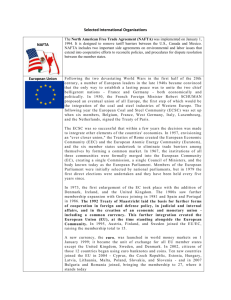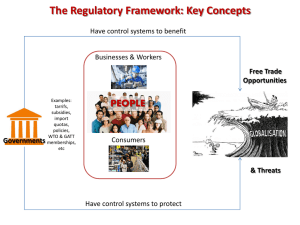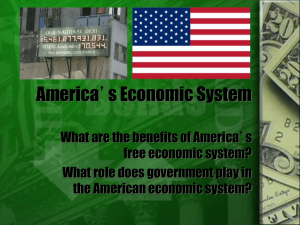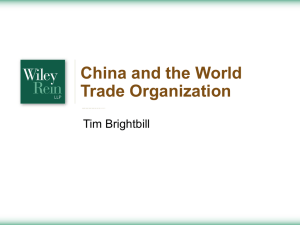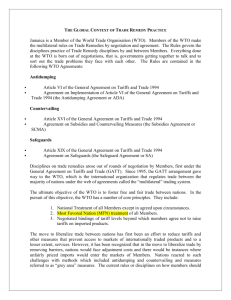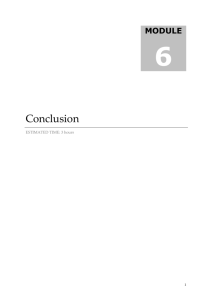Examples of green transformation measures and related trade
advertisement
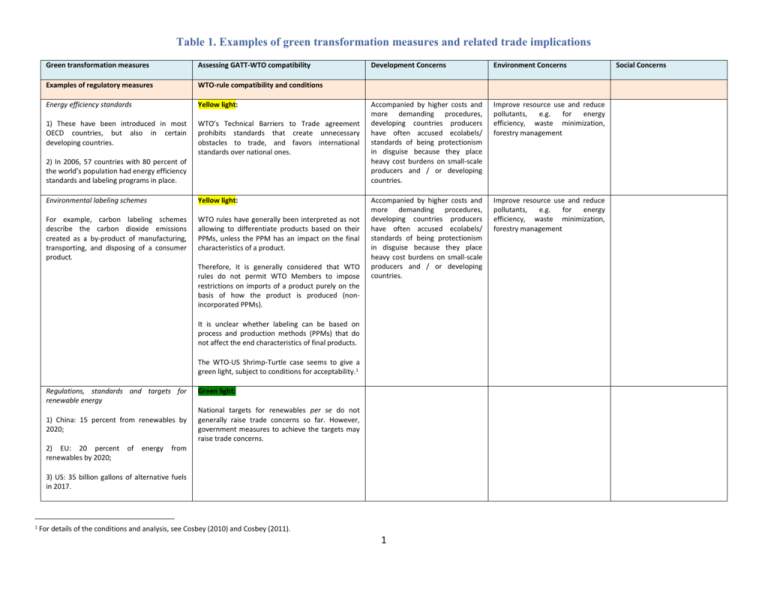
Table 1. Examples of green transformation measures and related trade implications Green transformation measures Assessing GATT-WTO compatibility Examples of regulatory measures WTO-rule compatibility and conditions Energy efficiency standards Yellow light: 1) These have been introduced in most OECD countries, but also in certain developing countries. WTO’s Technical Barriers to Trade agreement prohibits standards that create unnecessary obstacles to trade, and favors international standards over national ones. 2) In 2006, 57 countries with 80 percent of the world’s population had energy efficiency standards and labeling programs in place. Environmental labeling schemes Yellow light: For example, carbon labeling schemes describe the carbon dioxide emissions created as a by-product of manufacturing, transporting, and disposing of a consumer product. WTO rules have generally been interpreted as not allowing to differentiate products based on their PPMs, unless the PPM has an impact on the final characteristics of a product. Therefore, it is generally considered that WTO rules do not permit WTO Members to impose restrictions on imports of a product purely on the basis of how the product is produced (nonincorporated PPMs). Development Concerns Environment Concerns Accompanied by higher costs and more demanding procedures, developing countries producers have often accused ecolabels/ standards of being protectionism in disguise because they place heavy cost burdens on small-scale producers and / or developing countries. Improve resource use and reduce pollutants, e.g. for energy efficiency, waste minimization, forestry management Accompanied by higher costs and more demanding procedures, developing countries producers have often accused ecolabels/ standards of being protectionism in disguise because they place heavy cost burdens on small-scale producers and / or developing countries. Improve resource use and reduce pollutants, e.g. for energy efficiency, waste minimization, forestry management It is unclear whether labeling can be based on process and production methods (PPMs) that do not affect the end characteristics of final products. The WTO-US Shrimp-Turtle case seems to give a green light, subject to conditions for acceptability.1 Regulations, standards and targets for renewable energy 1) China: 15 percent from renewables by 2020; 2) EU: 20 percent renewables by 2020; of energy Green light: National targets for renewables per se do not generally raise trade concerns so far. However, government measures to achieve the targets may raise trade concerns. from 3) US: 35 billion gallons of alternative fuels in 2017. 1 For details of the conditions and analysis, see Cosbey (2010) and Cosbey (2011). 1 Social Concerns Green transformation measures Assessing GATT-WTO compatibility Examples of fiscal measures WTO-rule compatibility and conditions Domestic carbon and energy taxation Green light: 1) Energy taxes on consumption; Domestic carbon and energy taxes do not raise trade concerns as long as national treatment and non-discrimination principles apply. 2) Embedded carbon taxes proposed in some countries but actually implemented in few. Carbon/energy tax on imports or exports Yellow light: Border tax adjustment on imports/exports proposed in some countries but not yet implemented in any. 1) Under GATT rules border tax adjustments are possible for taxes levied directly on products. Development Concerns Environment Concerns Social Concerns Internalize environmental costs, e.g. for greenhouse gas emissions Internalize environmental costs, e.g. for greenhouse gas emissions 2) It is unclear whether adjustment can be made for taxes on unincorporated input (such as energy) during the production of goods. Subsidies and domestic support mechanisms part I Subsidies to biofuels are common in many developed and developing countries. Subsidies and domestic support mechanisms part II Red light: The SCM (subsidies and countervailing measures) agreement of WTO does not allow enterprise- and sector-specific subsidies, if they cause adverse effects for foreign producers. The Agreement prohibits two types of subsidies: those contingent on exports and those contingent on the use of domestic over imported goods.2 Subsidies to renewable energy Sustainable government procurement Green light: Green procurement policies in several countries Environmental factors can be taken into account in government procurement decisions under the WTO Agreement on Government Procurement (GPA). Examples measures WTO-rule compatibility and conditions of capacity development Trade facilitation, promotion, and financing, as well as Aid-for-Trade for green sectors3 Promote sustainable consumption and production through use of public purchasing Green light: Trade facilitation and trade finance do not 2 3 For a possible extensions of the scope of energy subsidies to include exemptions from user fees or general taxes and environmental externalities, see http://www.climatepolicyinitiative.org/ accessed on May 20th 2011. For illustrative green sectors, see Table 2. 2 Green transformation measures Assessing GATT-WTO compatibility Development Concerns Environment Concerns Social Concerns generally raise trade concerns so far. Note: The current institutional home for global trade rules and disciplines is WTO. However, the current WTO rules seem to be not clear on the principles for the design and implementation of trade-related instruments for a green economy, as there is no multilateral consensus on best practices yet. The aim of developing this table is to serve as a reference for policy deliberation on trade rules and green economy. Source: adapted from ICTSD, Climate Change and Trade on the Road to Copenhagen, 2008, http://ictsd.org/i/publications/12524/. For feedback, please contact: Wei Liu, liuw@un.org, +1-212-963-3212. 3
